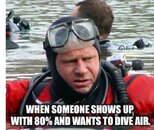helodriver87
Contributor
I did a deco dive a couple of years ago with a buddy. The bottom was something like 135'. We used Air for the bottom gas because neither of us felt like helium was needed for the specific conditions and Nitrox was not needed because we were not concerned with NDLs. Using Air was less expensive and the most convenient. We decided it was the best mix for the planned dive. We used a single deco gas of 80%, because we DID want to be prepared for significant surface surge that would make hanging at 20' more difficult and less pleasant than hanging at 30'.

Couldn't help it.
Edit (because this post needs some actual value):
I don't think arguing edge cases really has any value. One of the foundational assumptions of standard gasses is that they're rarely going to be ideal for a given dive, but that the benefits outweigh that (realistically) small disadvantage. If your dive is right on the edge of the recreational/technical divide, you need to approach it with the right mindset. In my opinion, that mindset isn't "what if I accidentally breathe some helium a few feet shallower than it's absolutely needed." Standard gasses simplify logistics, gas planning, deco, tank marking/gas switches, and team procedures. A few weird edge cases don't invalidate that or really even take much from it.





